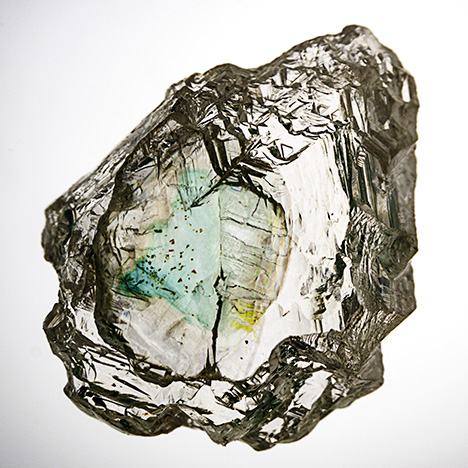Rough Diamond Fragment with a Large Green Cleavage Surface

A colorless 2.02 ct flattened diamond crystal fragment (see above), from Mr. Rowan Beach of San Francisco, was examined at GIA’s Carlsbad lab. The fragment exhibited a large bluish green internal surface that was readily visible without magnification. Initially thought to be a colorful mineral inclusion, it proved to be a radiation-induced coloration along the internal surface. When a diamond is irradiated (during laboratory color treatment or occasionally in nature), carbon atoms are removed from their normal position in the diamond lattice; this creates what scientists call the “GR1” optical defect (i.e., a vacant atom position in the lattice). The presence of this defect causes the diamond to selectively absorb light toward the red end of the visible spectrum, while the remaining portions are transmitted through the diamond and, when recombined, seen as a green or bluish green color. The GR1 optical defect can be removed in the lab by heating the diamond to over 600°C; this heating changes the green color to yellowish brown. The added energy allows a carbon atom to again occupy the vacant lattice position.
Green or bluish green color in diamonds is most often the result of exposure to a source of radiation in a geologic environment near the earth’s surface. The source of exposure could be a nearby grain of a radioactive mineral that gives rise to a small “radiation spot” on the outer surface. Conversely, the source could be a radioactive solution that was able to penetrate surface-reaching cleavages in the diamond. In both cases, the source produced alpha-particle radiation, which has a limited penetrating distance in diamond. As a result, the radiation spot or stain is confined to a zone close to the radioactive material. Such radiation stains are not uncommon in diamonds, though they are often removed by the faceting process.
The presence of a large green internal radiation stain indicates that this diamond was irradiated in a near-surface geological environment where temperatures high enough to modify the GR1 were unlikely. This means that the irradiation took place in the crust after the diamond was transported up from the mantle by the kimberlite magma eruption. Although the geographic origin of this rough diamond is uncertain, it is one of the more intriguing examples of a natural “radiation-stained” diamond we have seen.



